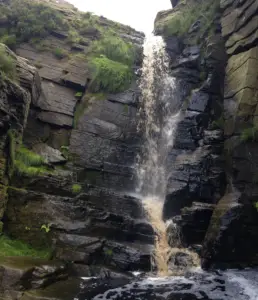
Wet rock can increase the grade of a scramble considerably, or even render the scramble extremely dangerous. Through my own experience wet rock for example on buttress or ridge of a grade two and above should only be tackled by experienced scramblers and a rope is highly recommended for safety.
Over the years scrambles have been graded in Scotland and England rather differently with the English system being given grades from 1 -3s (s for serious) and Scottish guidebooks using a system of grades 1 to 5.
UK Scrambles recommends a simpler way to grade the system that would cover the entire UK. What we propose is to remove the “s” from the English grading system and then to remove the “5” from the Scottish system, evening out the grades from 1- 4 for both areas, and thus removing any confusion between the two higher ended grades.
Grade 1 Scrambling
This grade is for an easy scramble with little or no hazards and easy route finding. What this grade does is to find the most interesting route / line up a gully, gill, ridge, or buttress where the exposure is not great and where the route can be varied at will. NOTE: wet conditions on this type of route could increase the difficulty and hazard level up to a grade two.
Classic grade 1 scrambles include:
- Jack’s Rake scramble in the Lake District.
- Crib Goch scramble in Snowdonia
- Tryfan North Ridge scramble in Snowdonia
- Red Brook scramble in the Peak District.
- Striding Edge in the Lake District.
Grade 2 Scrambling
This grade is for routes that contain longer difficult sections where a rope could be used for safety / confidence, short exposed sections of rock or grass, and or at a certain point in the scramble that requires a short rock climb to overcome a particularly obstacle.
(These can often be avoided though on grade two’s.) Some skill required for route finding.
Classic grade 2 scrambles include:
Grade 3 Scrambling
Escape is difficult! This grade is more serious and should only be undertaken by experienced scramblers. A rope is advised for some of the pitches of easy rock climbing where the exposure could be quite high, or where the scramble of a particular water fall could be hazardous. This route could also contain steep grassy sections which offer no hand holds and a slip could be fatal.
Classic grade 3 scrambles include:
- Dolmen Ridge scramble in Snowdonia
- Pinnacle Ride, St Sunday Crag, in the Lake District
- Cneifon Arete scramble in Snowdonia
- Elbow Ridge scramble in the Peak District.
Grade 3S/4/Mod Scrambling
This grade should only be undertaken by the most experienced of scramblers, and donates a particularly serious scramble. This route will contain exposed passages on steep rock or poor vegetation. Routes of this type will require the skill of rock climbing up to a v diff and mountaineering skills where the use of rope and other climbing equipment would be used for passage on key areas. Escape on these routes is difficult and could probably only be escaped from by means of an abseil. Exposure will be high in many parts along the route.
Using the star system
The star system indicates the quality of the route:
* Represents a route that has some good points and is worth a visit.
** Represents a route of more interest and a good sustained quality line.
*** Represents a classic route with good continues rock and a good line well worth a visit.

Hi all.
I’m not sure if this is the right page to post a request for some help but I would be very grateful for any advice on the following…
Earlier his year I scrambled up the Devil’s Kitchen in Cwm Idwal, Snowdonia went up to Y Garn and down the easier route back to the lake.
Really enjoyed it and was pretty proud to have done the DK as I really suffer from heights.
I didn’t find the scramble physically difficult and more importantly wasn’t daunted by the climb (or the descent) as I didn’t feel too exposed by any sheer drops etc next to me.
Next, I would love to go up the Brystly Ridge to then do the Glyders and back down the Devils Kitchen.
Having looked into the Brystly Ridge, it does seem (even by your brilliant video) to be quite a lot more exposed than the DK with pretty severe drops in places.
Is this the case and if so would this be recommended for someone with a fear of heights.
As an initial comparison, I see that the BR is a grade 1 scramble. What grade would the DK be? (Not listed)
I’ve been told that there’s an easier scree path to the left of the BR. Is that exposed too or worse in any way than walking down Y Garn.
The last thing I want to do is ‘freeze’ and cause problems, but given that I was ok with the DK scramble am I being to paranoid or should I leave BR alone..?!
I’d very much appreciate any thoughts and I thank you all in advance!
Hi Peter,
As far as I know, Devils Kitchen is ungraded (aka easier than a grade 1 scramble).
Bristly Ridge is at the higher end of grade 1 scrambles, so I would suggest you first start with an easier route, such as Tryfan North Ridge (in the same area).
Do it on a warm, dry day in the spring or summer, so avoid slippy rocks, and help build your confidence at the grade.
You can always look into hiring a guide or going on a scrambling course to get you into the harder routes.
All the best.
Hi Matt,
Thank you very much for your reply and suggestions.
Really sorry I didn’t thank you earlier! How rude!
I didn’t get a notification that a reply had been posted (not sure if I was meant to get one) and I’ve only just rechecked my original post.
Tryfan sounds like a good alternative although, having checked the OS Maps flythrough and various photos, the scree path to the side of the Bristly Ridge should be ok (with fear of heights) so I can get up to the Glyders.
Thanks again!
All the best
Peter
Hello Peter,
I’m also considering Bristly Ridge this spring. I’m told it’s marginally more difficult than Tryfan North Face, which I completed last year. In terms of vertigo, from which I also suffer a little, I had no problems on Tryfan. On the other hand I’m 75 and years of basketball have left little in the way of cartilage in my knees. There are a number of alternative routes and it’s relatively easy to pick one to suit your own temperament. The traditional jump on Adam and Eve may deter you as when you’re standing on one the edge of the other blots out the land immediately below the other and all you can see is an 800 metre drop.
I’d be interested to know how you managed Bristly Ridge if you decided on that one. Easier again from the vertigo point of view, in that area, is Y Gribbin. The spectacular panorama out to the sea is well worth the climb.
You could add a grade 0 for ungraded easy scrambles like the Devil’s Kitchen!I always thought that a scramble is where you have to use your hands for a significant part of the route.
I wonder if you could give examples from Scotland. I have recently done the Aonach Eagach, and was first really worried after all I had read. It gave me a lot of confidence, as I found it easy going (on excellent weather, I must add). So I decided to up my game and went to the Cuillin Ridge. I found Sgurr Dubh Mor from Sgurr nan Eag extremely difficult to negotiate still on excellent weather (I didn’t use the direct route): difficult route finding and very exposed climb-like sections. What are their grades? I need a reference. Thanks
Hi Nuria, the Cuillin Ridge is grade 3+ with several Severe grade climbing pitches, and represents the very top difficulty of what UK scrambles have to offer. The physical effort of the ridge is also extreme, with over 4,000 metres of ascent/descent while climbing. The difference between Aonach Eagach (Grade 2) and the Cullin Ridge is huge, so I recommend choosing some more difficult Grade 2 routes or some shorter Grade 3 routes first, which you can find in various Scottish scrambling books like Cicerone Scotland’s Ridge book here: https://amzn.to/2tkCzpH
I like the proposal of the grade 1 – 4 system for the whole UK. Just a minor quibble, though: the “S” in grade 3S stands for “Serious”, not “Severe”. “Severe” is a climbing grade and it would be confusing to use it to qualify a scrambling grade.
Thanks David, amended.